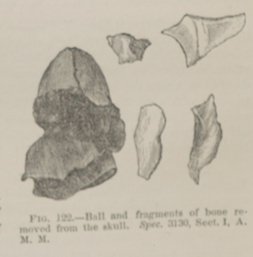Title: N——, Benjamin
Source text: Surgeon General Joseph K. Barnes, United States Army, The Medical and Surgical History of the War of the Rebellion. (1861–65.), Part 1, Volume 2 (Washington, D.C.: Government Printing Office, 1870), 253.
Civil War Washington ID: med.d1e16412
TEI/XML: med.d1e16412.xml
CASE.—Private Benjamin N——, Co. G, 19th Massachusetts Volunteers, aged 35 years, was wounded at Deep Bottom, Virginia, August 14th, 1864, by a conoidal musket ball, which passed through the zygoma and squamous portion of the left temporal bone and penetrated the brain. He was admitted into the hospital of the Second Corps at City Point on the 16th, being delirious at the time. On the following day, he was forwarded by hospital steamer to Washington, and admitted to the Emory Hospital in a comatose condition. His right side was paralyzed, pulse feeble and 105 per minute, and extensive ecchymosis existed around each eye. There was considerable laceration of the soft parts and extensive comminution of bone. The brain protruded and discharged from the opening. Chloroform was administered, and Surgeon N. R. Moseley, U. S. V., removed the ball and several spiculæ of bone, which had been forced into the brain. Cold water dressings were applied, and the patient was placed on the injured side to promote discharge. Calomel and strict antiphlogistic treatment were ordered, but death supervened on August 19th, 1864. An autopsy showed extensive laceration of anterior and middle lobes of brain. The ball had passed through a portion of pons varolii and the crura cerebelli of left side. The brain was considerably congested. The pathological specimen, represented by the wood-cut, shows a fragment of the squamous portion of the left temporal, with a conoidal ball half severed by the edge of the fractured bone. The fragments include one square inch of surface. The specimen was contributed by the operator, Surgeon N. R. Moseley, U. S. V.
